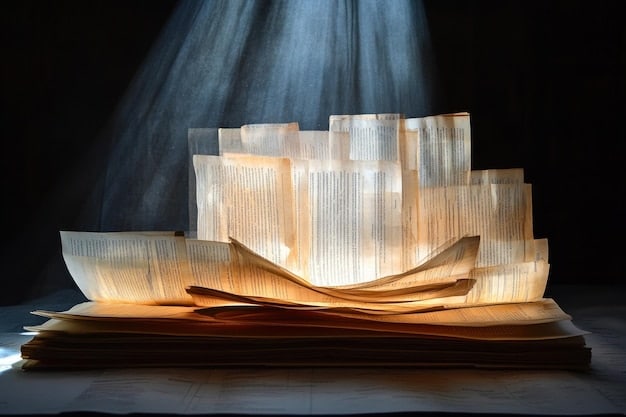Analyzing Archetypal Criticism in American Poetry: Unveiling Recurring Themes

Analyzing the Use of Archetypal Criticism in Understanding Recurring Themes in American Poetry reveals universal patterns in literature, offering insights into shared human experiences depicted across diverse American poetic works.
American poetry, rich in its diversity and depth, often echoes universal themes that resonate across cultures and generations. Analyzing the Use of Archetypal Criticism in Understanding Recurring Themes in American Poetry offers a powerful lens through which to explore these underlying motifs, revealing how poets tap into shared human experiences. This approach illuminates not only the individual poem but also the collective unconscious that shapes our understanding of the world. Let’s delve into how archetypal criticism enhances our appreciation of American poetry.
Introduction to Archetypal Criticism
Archetypal criticism, rooted in the theories of Carl Jung and further developed by literary critics like Northrop Frye, examines recurring patterns and symbols in literature. It posits that certain archetypes—universal characters, situations, and symbols—exist in the collective unconscious of humanity and appear across different cultures and time periods. Applying this critical approach to American poetry can reveal profound insights into the recurring themes that shape the nation’s literary identity.
Key Archetypes in Literature
Several archetypes frequently appear in literary works. Understanding these can help provide a framework for analyzing American poetry.
- The Hero: A character who embarks on a journey or quest, often facing trials and tribulations to achieve a goal.
- The Mother: A nurturing figure who provides support, comfort, and guidance with unconditional love.
- The Shadow: Represents the darker aspects of the human psyche, the suppressed or repressed desires and fears.
- The Wise Old Man: A mentor or guide who offers wisdom, knowledge, and guidance to the hero or protagonist.
Analyzing these archetypes within the context of American poetry reveals how poets engage with and transform these universal figures and situations to reflect their own cultural and historical contexts. Recognizing these deep-seated patterns enhances our understanding of the poem’s deeper meanings.

Analyzing the Use of Archetypal Criticism in Understanding Recurring Themes in American Poetry
Analyzing the Use of Archetypal Criticism in Understanding Recurring Themes in American Poetry demonstrates how critics dive deep into the symbology present within literary works. This critical lens allows readers to identify and interpret recurring archetypes, which in turn sheds light on the underlying themes. By systematically examining these elements, a more nuanced understanding of the literary work can be achieved.
Identifying Archetypal Patterns
To effectively utilize archetypal criticism, one must identify the recurring patterns within a text. These patterns are typically recognizable thematic elements such as birth, death, rebirth, the journey, and good versus evil. By recognizing these patterns, readers are better equipped to understand the significance of archetypes in the poem.
- Character Archetypes: Look for recurring roles such as the hero, the villain, or the mentor.
- Situational Archetypes: Recognize common situations like the quest, the fall, or the initiation.
- Symbolic Archetypes: Identify symbols such as water, fire, or colors that have universal meanings.
Analyzing instances of these archetypes throughout various American poems enables a thorough insight into the poem’s thematic layers and their interrelation with human understanding. This reinforces the concept that literature is a reflection of shared human experiences. In summary, by identifying and analyzing archetypal patterns, readers gain a deeper comprehension of American poetry and its connections to broader human themes.
The Hero’s Journey in American Poetry
The hero’s journey, a common archetype identified by Joseph Campbell, appears frequently in American poetry. It typically involves a protagonist who leaves their ordinary world, faces trials and tribulations, and ultimately returns transformed. This archetype offers a framework for exploring themes of identity, self-discovery, and societal change.
Examples of the Hero’s Journey
Several American poets have employed the hero’s journey archetype in their works.
- Walt Whitman’s “Song of Myself”: Whitman’s persona embarks on a spiritual journey, celebrating individuality and connection to the universe.
- Emily Dickinson’s poems: Dickinson’s speakers often undertake internal journeys, exploring themes of death, immortality, and the self.
- Robert Frost’s “The Road Not Taken”: The speaker faces a critical decision, symbolizing life’s journey and the choices that define us.
By examining these poems through the lens of the hero’s journey, readers can appreciate how poets use this archetype to explore complex themes of identity, transformation, and societal values. In conclusion, the hero’s journey archetype highlights common experiences portrayed in American poetry, fostering new connections between the text and the reader.

The Theme of Nature and the Mother Archetype
Nature, a recurring theme in American poetry, is often associated with the mother archetype. In this context, nature symbolizes the source of life, nourishment, and comfort. Poets use natural imagery to evoke feelings of connectedness, spirituality, and the cycle of life and death. This archetype reflects humanity’s deep roots in the natural world.
Poetic Depictions of Nature
American poets frequently portray nature as a nurturing and restorative force.
- Ralph Waldo Emerson’s “Nature”: Emerson celebrates the transcendental power of nature, seeing it as a source of spiritual renewal.
- Mary Oliver’s poems: Oliver finds solace and wisdom in the natural world, often depicting nature as a source of healing and inspiration.
- Robert Frost’s pastoral poems: Frost explores the complexities of human interaction with nature, portraying both its beauty and its challenges.
Analyzing nature as the mother archetype in these poems reveals how poets use natural imagery to explore themes of belonging, regeneration, and the interconnectedness of all living things. By highlighting nature’s nurturing aspects, poets enrich their work with deeper emotional and symbolic depths, strengthening the reader’s connection. Consequently, using this archetype in American poetry gives profound insight.
The Shadow and its Manifestations in Poetry
The shadow archetype represents the darker, repressed aspects of the human psyche. In American poetry, it manifests as themes of guilt, fear, alienation, and moral ambiguity. Poets often use the shadow to explore the complexities of human nature and the darker undercurrents of society. This archetype challenges traditional notions of good and evil.
Explorations of the Shadow
Several American poets have delved into the shadow archetype in their works:
- Edgar Allan Poe’s poems: Poe explores themes of death, madness, and the macabre, reflecting the darker side of human experience.
- Sylvia Plath’s poems: Plath confronts themes of depression, trauma, and the destructive forces within the self.
- Langston Hughes’s poems: Hughes addresses the social and psychological impact of racism and discrimination, revealing the shadow of American society.
Examining these poems through the lens of the shadow archetype reveals how poets use imagery and symbolism to confront difficult and often uncomfortable truths about human nature and society. The shadow archetype encourages readers to confront their own internal conflicts and acknowledge the complexities of the world. Analyzing the Use of Archetypal Criticism in Understanding Recurring Themes in American Poetry can reveal complex nuances.
Analyzing Recurring Themes Through Archetypal Criticism
Analyzing the Use of Archetypal Criticism in Understanding Recurring Themes in American Poetry allows for the surfacing of hidden meanings and cultural relevance within literary texts. Common archetypes such as the trickster, the innocent, and the ruler appear frequently, offering rich interpretive possibilities. Recurring themes of love, death, betrayal, redemption, and perseverance are all examined in depth.
Benefits of Archetypal Analysis
Using archetypal criticisms offers distinctive advantages for interpreting verse which include highlighting prevalent themes and cultural relevance.
- Enhances Deeper Comprehension: Reveals universal patterns that resonate with readers on a subconscious level.
- Highlights Cultural Context: Offers insights into the cultural and historical forces shaping the poems.
- Encourages Critical Thinking: Promotes nuanced interpretations of complex themes and symbols.
Understanding these archetypes reinforces the significance of literary works and their ability to mirror human experiences. This critical use of interpretation also fosters a critical engagement with literature helping readers connect to broader human themes. By facilitating access to the collective knowledge, the reader gains a deeper appreciation of American poetry and the human condition.
| Key Point | Brief Description |
|---|---|
| 💡 Archetypal Criticism | Examines recurring patterns in literature to reveal universal themes. |
| 🦸 Hero’s Journey | A protagonist undergoes transformation through trials and self-discovery. |
| 🌱 Nature as Mother | Nature linked to nurturing and the cycle of life in poetry. |
| 🌑 The Shadow | Represents the darker aspects of human nature and society. |
Frequently Asked Questions
Archetypal criticism examines recurring patterns and symbols in literature, suggesting these archetypes reflect universal human experiences. Analyzing the Use of Archetypal Criticism in Understanding Recurring Themes in American Poetry reveals profound connections.
Carl Jung’s theories on the collective unconscious laid the groundwork for archetypal criticism. Northrop Frye further developed the approach in a literary context, examining recurring myths and symbols across cultures.
The hero’s journey, a common archetype, often appears in American poetry to explore themes of self-discovery, societal change, and the trials individuals face. Analyzing the Use of Archetypal Criticism in Understanding Recurring Themes in American Poetry helps highlight this.
Nature often symbolizes the mother archetype, representing sources of life, nourishment, and comfort. Poets use natural imagery to evoke feelings of connectedness, spirituality, and the cycle of life and death in their work.
Yes, the shadow archetype representing the darker, repressed aspects of the human psyche manifests in contemporary poetry through themes of guilt, fear, alienation, and moral ambiguity. Analyzing the Use of Archetypal Criticism in Understanding Recurring Themes in American Poetry highlights these darker elements.
Conclusion
In conclusion, analyzing the use of archetypal criticism in understanding recurring themes in American poetry offers a rich and insightful approach to literary analysis. By recognizing and interpreting these universal patterns, readers can gain a deeper appreciation of the diverse and enduring themes that shape American literature.





